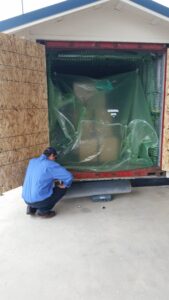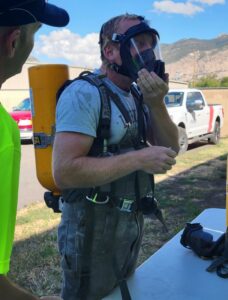Safety First in Fumigation
Safety First in Fumigation
Fumigation is a highly effective tool for managing pests, but it is a tool that needs to be used smartly, safely, and performed by a highly trained, experienced professional. Sprague Pest Solutions checks all the boxes.
Sprague performs thousands of fumigations annually for a myriad of facilities and equipment. Whether it’s commodity container fumigations in California, rail cars in Utah, or grass seed warehouses in Oregon, Sprague has the expertise to address the unique requirements of each client and situation.
The Challenge
Fumigation is a more complex process than other routine pest control services. Gas fumigants have a different mode of action and must be handled and applied differently. Even though fumigation work in the commercial sector is done in a more controlled environments than structural fumigation of homes or apartment buildings, fumigation crews must undergo more intensive, annual U.S. EPA mandated training.
Another factor is that there is no one-size-fits-all approach to a fumigation, each job must be tailored to the specific pest, commodity, and design of the facility.

Sprague performs thousands of fumigations annually for a myriad of facilities and equipment.
For instance, Sprague partnered with a large seed warehouse experiencing a persistent rodent issue. The mice were continually being introduced into the facility within incoming seed shipments. Under normal circumstances this would be a relatively straightforward fumigation but a structural condition at the warehouse stalled that approach.
There were multiple holes and openings in one wall of the warehouse that not only allowed mice to gain access to the structure’s attractive food source but also made fumigation impossible. Without a solid seal the gas would leak out, missing the target pest, posing an unnecessary risk to warehouse personnel, Sprague applicators, and non-target animals.
Sprague collaborated with the facility’s maintenance team to repair and seal the deteriorating wall, ultimately solving the potential leakage issues, allowing for a successful fumigation to be performed that eliminated the rodent issue.
“This was an example of the process being more than a fumigation,” says Ashley Roden, Sprague’s technical/quality assurance manager. “It was root cause problem solving and using an integrated pest management approach to come up with a resolution that allowed us to deliver the desired treatment and provide a solution for the client.”
The Solution
Working to identify and implement solutions, as was the case in the example with the seed warehouse, is a result of extensive fumigation training and safety education. Sprague emphasizes hands-on, in-person training that goes deeper into the subject than most companies offer.

Providing hands-on training is critical to making sure fumigations are done safely and correctly, meeting and exceeding both the clients’ expectations and regulatory requirements.
“Providing hands-on training is critical to making sure the job is done safely, correctly and meets and exceeds both the clients’ expectations and regulatory requirements,” says Roden. “Sitting watching a PowerPoint presentation doesn’t cut it. We want them to show us what they know and what they don’t about fumigation.”
Every spring Sprague conducts multi-day in-person fumigation training workshops in its Eastern Washington and Northern California service centers. These workshops feature detailed interactive sessions on the latest fumigation technology, application methods, safety protocols, and industry regulations.
Hands-on training sessions allowed participants to train in equipment calibration, proper dosage rates, monitoring, aeration, using personal protective equipment (PPE), how to write fumigation and emergency response plans, and troubleshooting techniques under real-world conditions.
“Sprague goes above and beyond when it comes to offering fumigation training for its crews,” says Justin Bruecker, business development manager for Douglas Products, who participated as an instructor at Sprague’s fumigation workshops. “They are committed to ensuring not only the efficacy of the treatment, but to the safety of their crews and clients’ employees.”
The Result
A successful fumigation job provides food processing, storage, and transportation clients with confidence their products are pest-free and won’t be subjected to product recalls and financial losses. Having the work performed by highly trained professionals that place safety first adds to the value proposition.
Roden says the bar for fumigation training and safety is set high at Sprague and that preparation and communication both internally and with clients is essential.
“Our clients expect results, but they want it done safely,” says Roden. “They want peace of mind the work is done by professionals who know their craft and pay attention to the details from start to finish.”
Doug Belle of Cardinal Professional Products, who has also attended the workshops, had this observation on the value of events.
“Sprague’s investment in fumigation training and safety, even asking for more than the required training, sends a message they are not only good stewards of the service, but the environment as well,” says Belle.
Five Musts in Fumigation Safety
- Make sure your clearance device is calibrated properly and can validate the required clearance level.
- Have Self-Contained Breathing Devices (SCBAs) on hand and ready along with PPE and other safety equipment. Test it regularly.
- Double check, follow up and communicate – locks, seals, head count, etc. – before the gas is applied; communicate with clients and crews.
- Designate a clear point person on the job and have documented fumigation and safety plans available to all – make sure everyone is on the same page.
- Be adaptable to changing conditions and adjust as necessary to ensure the effectiveness of the treatment and the safety of the crew and client.
For more information on how Sprague Pest Solutions can design an effective fly or pest management program for your facility, call 855.805.0755.
